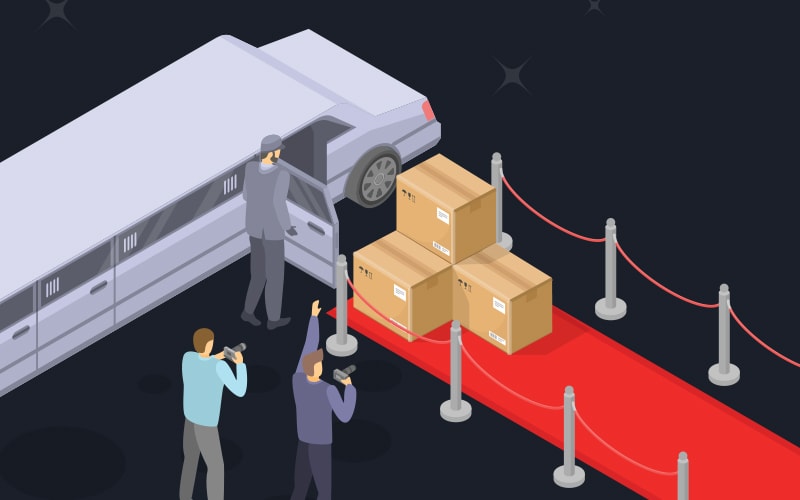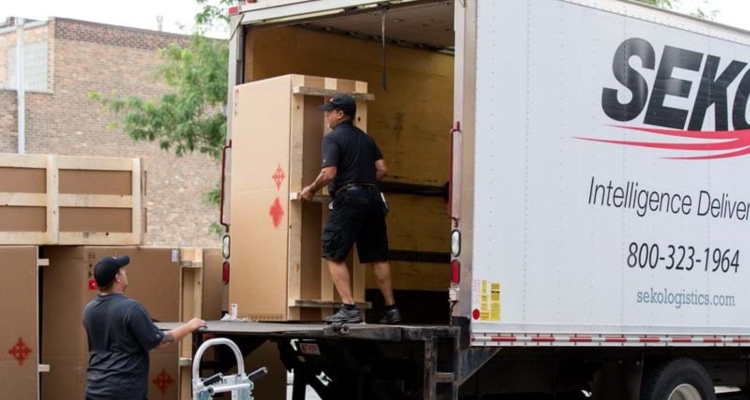White-Glove Delivery: Giving Your Shipments the Red-Carpet Treatment

When a shipment needs VIP treatment, retailers give white-glove delivery services a royal welcome.
From an icy enclave in the Arctic to a retail store down the street, white-glove delivery service takes many forms—everything from placing a new sofa in a homeowner’s rec room to installing a single computer server in a restaurant’s tech closet to setting up complex medical devices. But the desired outcome is always the same: make the customer happy.
The definition of white glove encompasses a wide range of services, depending on customer needs. Basically, it’s the next step beyond final-mile service, which delivers a product to the customer’s dock or curb. With white-glove service, providers take the product to the customer’s specific location of choice and install it or set it up for use.
As consumers become more comfortable buying large items online, and brands go all in on reducing the amount of stock in retail locations, white-glove service will continue to play a significant role in the fulfillment space. Parcel and LTL carriers will continue to purge big and bulky items that make their networks inefficient, shifting more volume to white-glove service options.
For their part, shippers are leaning toward white-glove service as a way to consolidate oversized shipments. Instead of sending, say, five bar stools in three oversized parcel deliveries, the shipper consolidates that order into one pallet load for white-glove delivery.
Data Centers Get Some Love

While furniture and home appliances have long embraced white-glove delivery, it is now gaining traction across a wider spectrum of industries. SEKO Logistics, for example, has added data centers to its roster of white-glove customers.
Long a staple in the furniture and home appliance industry, other sectors are embracing white-glove services as well. The growth of artificial intelligence and the remote work trend has created a surge in white-glove deliveries for data centers, for instance.
“Constant growth and refurbishment of high-tech equipment exists primarily within data centers,” says Brian Bourke, global chief commercial officer for SEKO, a global logistics provider.
Data centers are adding capacity, and outdated equipment has to be upgraded to handle the new workload. White glove provides an ideal scenario for deliveries to these data centers—even when they are located at the ends of the earth.
In one extreme example, SEKO Logistics delivered data center gear to a location above the Arctic Circle, where the items had to acclimate to the local weather for hours until they could be installed.
FAILURE IS NOT AN OPTION
Unlike shipping from dock to dock, there is no telling what a delivery driver might encounter in a white-glove scenario.
At the consumer level, that means doing whatever it takes—such as removing the door and then putting it back on—to get a new refrigerator into the customer’s kitchen.
At the commercial level, white-glove service could entail delivering complex medical equipment for demonstration use and picking it back up again or installing customized rooms for private video calls as employees return to work in open floor plan offices.
Customers, both consumer and commercial, have high expectations for service when they order expensive items for delivery. That also means the seller assumes liability for the product going into the customer’s location.
“Companies used to be able to deliver a $7,000 couch to the street, and the customer took care of it from there,” says Nick Brown, director of supply chain solutions for enVista, a supply chain technology consultant. “Now the shipper is responsible for getting it into the customer’s room of choice.”
Complexity and timing raise the stakes for white-glove deliveries. “These projects are time sensitive and often delivered in the off-hours and sometimes even weekend off-hours. When we deliver to a downtown location, for instance, we have issues like having to close off streets,” says Bourke.
Consumers also see white-glove delivery contractors as representatives of the company for whom they are delivering: 41% of consumers blame the brand when orders arrive late, according to a Loqate survey. This raises the pressure on white-glove service providers.
“If we deliver for a fitness company, the consumer looks at us like we are that fitness company,” says Rob Lamell, vice president of home delivery-U.S. for AIT Worldwide Logistics, a global transportation provider. “We are an extension of our client to their end consumer.”
Metrics THAT MATTER
For white-glove service, on-time delivery isn’t necessarily the most critical metric for success. Other factors, such as proof of damage-free delivery and compliance with procedures, are essential benchmarks.
“The definition of on-time delivery has become more nuanced because arriving early can be just as bad as arriving late,” Bourke says.
Customer service metrics are also key. Positive customer reviews are the currency that helps consumers build a comfort level with white-glove delivery services.
“Consumers like to shop at retail stores, and we have a big job in extending that experience into the home,” says Luis Escobar, director of operations, home delivery, for AIT, which delivers furniture, fitness equipment, and outdoor structures such as gazebos and gym sets via white-glove service.
The same emphasis on service applies to industrial settings. For example, when SEKO Logistics returns medical devices to a warehouse, the company must prove that the units have been properly disinfected and all accessories have been collected for return. SEKO helps customers track the expensive accessory kits to ensure the inventory goes where it belongs.
“Each client measures us differently, and on-time delivery is one metric, but it’s not always the metric when it comes to white glove,” Bourke says.
Some products include their own built-in feedback that white-glove providers can use to track success. Data server racks, for instance, have a tip-and-tell device that records if the shipment tipped past a certain point that could cause damage to the server. Through the SEKO Live app, drivers can send photos to the shipper to find out how to address the situation if it occurs.
White-glove providers also use vehicle routing and scheduling systems to boost customer experience. These technologies—often available to drivers directly via an app—can collect and communicate attributes of delivery locations, so when drivers arrive, they know the parameters for delivery and assembly, including specifics like whether or not a loading dock is available, whether they need a key code to enter the facility, and if any hours are off-limits.
“The goal is to make the driver’s job as easy as possible to get as much throughput as possible,” says Brown of enVista.
These apps and technologies also play a role in the customer experience after a delivery is complete by enabling photographic proof of delivery, paperless forms, surveys, customer feedback, and other features.
TECHNOLOGY ENABLES OVERSIGHT
To ensure excellent customer service in the white-glove sector, management oversight is critical, according to AIT’s Escobar.
The company has built a regional field organization for its delivery and assembly services that can service every ZIP code in the country; 16 district managers vet and monitor contractors in their areas. The district teams benchmark contractor performance through a dashboard of compliance and deadlines.
In major markets, there may be some contractors that specialize in fitness equipment while others focus on furniture assembly. In a smaller market, one contractor may do it all.
AIT has travel teams ready to go to a customer site if a local contractor isn’t available. Customers assign contractors ratings, which AIT then uses to guide the jobs the contractors receive. “That allows us to continuously improve because we put the bulk of our work with the contractors that perform the best,” Escobar says.
Drivers for AIT use the next-stop feature in their mobile app, which alerts the customer when the truck is on the way to their location. Other milestones can trigger alerts as well.
“In our reviews, customers note how great it is to see the truck roll up and the delivery is aligned with the arrival information on their app,” Escobar says.
Drivers send proof-of-delivery photos through the app to verify they have completed an installation correctly and removed packaging material. The retailers AIT serves have access to the same photos for quality assurance. AIT field personnel conduct random spot checks to ensure the photos are of actual completed services.
A Little Help From Tech
“Our technology plays a big role in enabling us to elevate that level of service for our customers,” adds Lamell.
AIT also sends a customer survey 15 minutes after a delivery to quickly gauge the customer experience. A positive survey result is forwarded to the contractor as reinforcement. A negative result, or one where the customer indicates the experience wasn’t entirely satisfying, goes to district management for follow up.
By contrast, as a freight forwarder, SEKO takes ownership and liability of shipments, so it relies on its own network of proven carriers. The company vets and approves carriers, with some focusing on specific verticals such as medical installations.
With the many complexities surrounding white-glove delivery—and the likelihood the service will continue to grow in use cases—providers stay laser-focused on how they can deliver the best service to continue to meet customer demand.
“Issues always arise,” Bourke says. “The key is helping resolve them as positively as we can.”
WHITE GLOVE IN ACTION: No Room For Error
 Room, a Brooklyn, N.Y.-based manufacturer of soundproof office pods and phone booths, delivers its products to corporate workspaces, such as office buildings and co-working spaces, and is seeing growth in non-traditional end users, such as universities and libraries. Each delivery is unique in terms of access, security requirements, municipal building codes, and many other factors. They all require a white-glove approach.
Room, a Brooklyn, N.Y.-based manufacturer of soundproof office pods and phone booths, delivers its products to corporate workspaces, such as office buildings and co-working spaces, and is seeing growth in non-traditional end users, such as universities and libraries. Each delivery is unique in terms of access, security requirements, municipal building codes, and many other factors. They all require a white-glove approach.
Delivery success starts with the initial contact with Room’s customer, typically someone in the sales department. First, the Room team checks the dimensions to ensure the office pod will physically fit in the customer’s facility. Then, it develops a pre-delivery planning guide to capture details like utilities, local code compliance, loading dock and freight elevator use, and delivery requirements.
“We try to make it as simple as possible for our customers, who might not be used to doing these large installs,” says Sam Krotz, director of services. “We coach them on checking with their building management about requirements and then also making sure their space inside is prepared for the build.”
Customers selecting Room’s smaller, less complex booths can typically complete the install on their own. For larger, more elaborate installations that incorporate networking, cameras, and display technology, Room contracts with the Office Moving Alliance, a consortium that manages installation specialists in markets across the country.
Room provides these specialists with digital checklists, accessed via Room’s app, that require photo or video documentation to prove everything is working. The app is cloud-based, so anyone within the company can comment or provide troubleshooting information in real time. QR codes in assembly manuals direct installers to more detailed videos and instructions for each product. And for some customers, Room uses video call software to communicate with the on-site installation team.
The Room team reviews and analyzes the documentation sent after each installation. A project can be flagged as “no follow-up is required” or “visit is required.” A re-visit could be due to a manufacturing issue, such as missing or broken parts, or an installation problem. The customer may ask for additional instructions on how to use the video conferencing software and hardware.
“We ask our installers to flag that for us so that we can proactively reach out to the customer with next steps if something goes wrong,” Krotz says.
For Room, premier white-glove service is crucial to the success of the business, she adds.
